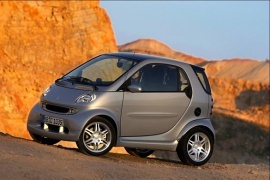
SMART fortwo Brabus
Generations Timeline, Specs and Pictures

To celebrate the tenth anniversary of cooperation between SMART and Brabus, the carmaker made a unique version for the ForTwo range in 2012.
After more than 50,000 ForTwo sold with the Brabus badge on it, it was the most successful product from the Bottrop tuning company laboratories. The tuner used the facelifted version of the ForTwo for the anniversary model, enhanced it accordingly, and built it in a limited 100 units.
At the front, the smoked boomerang-style headlights showed a meaner look. A pair of DRLs accompanied them in the front bumper’s apron. A mesh-grille adorned the front fascia and resembled some other Brabus performance products. Yet, it wasn’t a car built for high speeds. It was more of a fashion item. On the sides, the light-alloy wheels sported a six double-spoke design with three lug-nuts unique for the Brabus version.
Inside, the carmaker added more exclusive items such as Brabus-embroidered headrests for the sport bucket seats. Its dashboard featured a contrasting red line around the instrument panel and in front of the passenger. The door cards received the same red-line treatment completing the image of an exclusive vehicle.
But Brabus worked on the engine as well and added a few ponies. The one-liter, inline-three turbocharged powerplant provided 102 hp, enough to propel the telephone-booth sized vehicle to 100 kph (62 mph) from standing still in less than nine seconds.

In 2007, SMART introduced the second generation of the ForTwo range and unveiled the entire lineup, including the Brabus-tuned version at the Frankfurt International Motor Show.
Mercedes-Benz pushed the SMART brand harder on the market when it unveiled the second generation of the smallest and lightest car on the market. SMART developed the car together with Mitsubishi, who already had vast experience in small-displacement engines, especially due to its kei-cars developed for the Japanese market. Then, the German tuner Brabus joined the club and offered a higher-power version for the ForTwo Coupe.
At the front, the 2007 model featured boomerang-shaped headlights above the smiling grille. There was no way how to tell where the bumper was ending, and the rest of the plastic body panels continued. A mesh pattern adorned the upper and lower front grilles. The carmaker extended the roof with a small spoiler in the back, at the top of the rear windscreen. Brabus added a touch of its tuner expertise and installed a new set of light-alloy wheels with a six double-spoke design. In the back, it installed a twin exhaust in the middle.
Inside, the Smart Brabus received a unique, two-tone interior. The leather-clad bucket seats sported the Brabus logo embroidered into the headrests. On the dashboard, the tuner added aluminum trims, inducing a “racy” experience.
Under the hood, the carmaker installed the same one-liter turbocharged gasoline unit. Brabus took that inline-three Mitsubishi-sourced engine and tuned it to produce 98 hp. Its sequential gearbox worked was also improved over its previous generation, offering shorter gear-change times.

While everybody thought that the SMART ForTwo was built for congested traffic situations and very tight parking spots, Brabus thought it could make the small vehicle a go-kart with a roof.
When someone said “rear-engine, sequential gearbox, rear-wheel-drive” vehicle, a few thought about a SMART and more thought about a supercar, or even a race-car. After all, back in 2003, there were just a few cars to feature those technical details. But make no mistake: it was a SMART and not even the coupe version.
The little roadster received special treatment from the German tuner, and it was noticeable. It featured a restyled bumper and a pair of tiny fog-lights installed next to a grille at the front. The car needed the wheel fenders wider look to cover the new, wider wheels from its sides. Brabus designed a new set of alloys for the car and resembled the AMG ones from the C-Class. In the back, the tuner offered a twin exhaust system with the pipes coming out in the center, under the bumper, with chromed tips.
Inside, Brabus insisted on fitting the car with a few details that made the vehicle more appealing. Its sport-bucket seats with higher bolstering than the regular ForTwo ones. On the other side, Mercedes insisted that the car should feature top-notch safety systems and installed standard ABS and ESP.
SMART installed the engine under the trunk, and Brabus had to deal with that and upgrade it. In the end, the Brabus engineers managed to squeeze a few more ponies from the tiny three-cylinder engine. The result was a much more expensive ForTwo, but not a faster one.























































